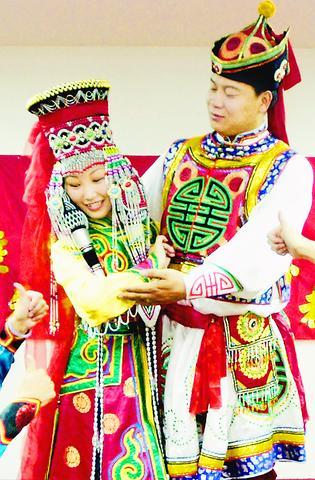The prospect of glimpsing a traditional wedding ceremony takes tourists to the grasslands of Inner Mongolia every summer, but not everyone can afford the time or money to experience first hand the culture and nomadic traditions that have been cultivated over thousands of years. The Inner Mongolia Folk Arts Troupe is trying to overcome this obstacle by taking its cultural performances on the road.
Minus the grasslands and herds of sheep and cattle, program director Dong Zhi-ming (董志敏) hopes his 32-member cast and crew can recreate the atmosphere and unique experience of a traditional Ordos wedding for local concert-goers in Taiwan.
"Of course, nowadays the wedding ceremonies that are usually performed are much simpler, but we want to perform the traditional ceremony, the way it was performed hundreds of years ago," Dong said.

PHOTOS COURTESY OF HANLIN MASS COMMUNICATION CO LTD
It was after the establishment of the Yuan Dynasty (1271 to 1368) by Kublai Khan (Genghis Khan's grandson) that the Mongolian spoken and written language is said to have developed. This is also the time when the rituals and customs performed during the Ordos marriage ceremony flourished.
In order to accurately re-enact the ceremony it will be performed in Mongolian, but as the director insisted, "You don't know need to know Mongolian to understand. You can understand by watching," Dong said, adding that there would be an explanation in Mandarin at the beginning of the performance.
The traditional Mongolian opera-style song and dance that would normally take several days at a wedding has been condensed into three parts for a 90-minute performance.
The first part tells of the groom's travels with his friends and relatives to fetch his bride from her family's home. The second and longest portion of the show is the actual marriage ceremony with vows and blessings. The party concludes with congratulatory speeches.
Sponsored by the Mongolian and Tibetan Affairs Commiss-ion, this is the third time the troupe has been invited to perform in Taiwan. In an effort to increase awareness and understanding of Mongolian culture, the commission holds various public events in cities around the island throughout the year.
Without much advertising and regardless of the nasty weather conditions (it rained heavily all day) the troupe's last performance in 2001 brought hundreds to Taipei's 228 park. This year's event is also free, but will be held inside at the Sun Yat-sen Memorial Hall. Further information, including additional performance dates is available on-line in Chinese at www.mtac.gov.tw.
Performance notes:
What: Inner Mongolia Folk Arts Troupe performance
(
When: July 28, 7:30pm.
Where: Sun Yat-sen.
Memorial Hall (
Tickets: Free and available now at Sun Yat-sen Memorial Hall.

June 23 to June 29 After capturing the walled city of Hsinchu on June 22, 1895, the Japanese hoped to quickly push south and seize control of Taiwan’s entire west coast — but their advance was stalled for more than a month. Not only did local Hakka fighters continue to cause them headaches, resistance forces even attempted to retake the city three times. “We had planned to occupy Anping (Tainan) and Takao (Kaohsiung) as soon as possible, but ever since we took Hsinchu, nearby bandits proclaiming to be ‘righteous people’ (義民) have been destroying train tracks and electrical cables, and gathering in villages

Swooping low over the banks of a Nile River tributary, an aid flight run by retired American military officers released a stream of food-stuffed sacks over a town emptied by fighting in South Sudan, a country wracked by conflict. Last week’s air drop was the latest in a controversial development — private contracting firms led by former US intelligence officers and military veterans delivering aid to some of the world’s deadliest conflict zones, in operations organized with governments that are combatants in the conflicts. The moves are roiling the global aid community, which warns of a more militarized, politicized and profit-seeking trend

The wide-screen spectacle of Formula One gets a gleaming, rip-roaring workout in Joseph Kosinski’s F1, a fine-tuned machine of a movie that, in its most riveting racing scenes, approaches a kind of high-speed splendor. Kosinski, who last endeavored to put moviegoers in the seat of a fighter jet in Top Gun: Maverick, has moved to the open cockpits of Formula One with much the same affection, if not outright need, for speed. A lot of the same team is back. Jerry Bruckheimer produces. Ehren Kruger, a co-writer on Maverick, takes sole credit here. Hans Zimmer, a co-composer previously, supplies the thumping

Dr. Y. Tony Yang, Associate Dean of Health Policy and Population Science at George Washington University, argued last week in a piece for the Taipei Times about former president Ma Ying-jeou (馬英九) leading a student delegation to the People’s Republic of China (PRC) that, “The real question is not whether Ma’s visit helps or hurts Taiwan — it is why Taiwan lacks a sophisticated, multi-track approach to one of the most complex geopolitical relationships in the world” (“Ma’s Visit, DPP’s Blind Spot,” June 18, page 8). Yang contends that the Democratic Progressive Party (DPP) has a blind spot: “By treating any